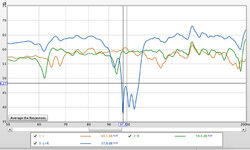travman83
New Member
Thread Starter
- Joined
- Feb 9, 2021
- Messages
- 6
More
- Preamp, Processor or Receiver
- Marantz SR8012
- Main Amp
- Anthem MCA 325
- DAC
- Schiit Modius
- Front Speakers
- B&W 703 S2
- Center Channel Speaker
- HTM 71 S2
- Surround Speakers
- B&W 707 S2
- Front Height Speakers
- RSL c34e
- Rear Height Speakers
- RSL c34e
- Subwoofers
- Dual SVS SB-3000
- Video Display Device
- LG 77 C9
- Streaming Equipment
- Bluesound Node 2i
Hello everyone,
I've been tinkering with my HT audio for several months, but this is my first time posting. I have taken some REW measurements for my FR, FL, and FR+FL speakers from the MLP that are stumping me. These measurements are post-Audyssey and without subs. The speakers when measured individually (green and orange) don't show any noticeable boundary cancellations, but when measured together (blue) I'm getting a significant cancellation at ~100hz. Any thoughts on what this could be from or how I can address it? The speakers are equidistant from the listening position making a rough equilateral triangle and about 2.5 ft from the back wall. The left side of the room opens into a larger area and the right side is walled off with the speaker ~3.5 ft away. Any thoughts are appreciated!
I've been tinkering with my HT audio for several months, but this is my first time posting. I have taken some REW measurements for my FR, FL, and FR+FL speakers from the MLP that are stumping me. These measurements are post-Audyssey and without subs. The speakers when measured individually (green and orange) don't show any noticeable boundary cancellations, but when measured together (blue) I'm getting a significant cancellation at ~100hz. Any thoughts on what this could be from or how I can address it? The speakers are equidistant from the listening position making a rough equilateral triangle and about 2.5 ft from the back wall. The left side of the room opens into a larger area and the right side is walled off with the speaker ~3.5 ft away. Any thoughts are appreciated!












